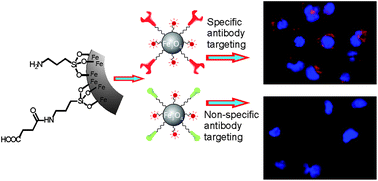Multifunctional Fe3O4nanoparticles for targeted bi-modal imaging of pancreatic cancer†
Abstract

* Corresponding authors
a
Department of Chemistry, University of Liverpool, Crown St, Liverpool, United Kingdom
E-mail:
m.j.rosseinsky@liverpool.ac.uk
Fax: +44-151-794-3589
Tel: +44-151-794-2297
b
Department of Molecular and Clinical Cancer Medicine, 5th Floor UCD Building, Royal Liverpool University Hospital, Daulby St, Liverpool, United Kingdom
E-mail:
halloran@liverpool.ac.uk
Fax: +44-151-706-5798
Tel: +44-151-706 -4087
c Imaging, Proteomics and Genomics Research Group, University of Manchester, Oxford Road, United Kingdom

 Please wait while we load your content...
Something went wrong. Try again?
Please wait while we load your content...
Something went wrong. Try again?
C. I. Olariu, H. H. P. Yiu, L. Bouffier, T. Nedjadi, E. Costello, S. R. Williams, C. M. Halloran and M. J. Rosseinsky, J. Mater. Chem., 2011, 21, 12650 DOI: 10.1039/C1JM11370D
To request permission to reproduce material from this article, please go to the Copyright Clearance Center request page.
If you are an author contributing to an RSC publication, you do not need to request permission provided correct acknowledgement is given.
If you are the author of this article, you do not need to request permission to reproduce figures and diagrams provided correct acknowledgement is given. If you want to reproduce the whole article in a third-party publication (excluding your thesis/dissertation for which permission is not required) please go to the Copyright Clearance Center request page.
Read more about how to correctly acknowledge RSC content.
 Fetching data from CrossRef.
Fetching data from CrossRef.
This may take some time to load.
Loading related content
